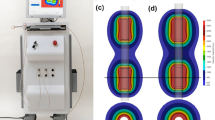Abstract
Enzyme ablation of the hyperplastic prostate may be an ideal method of management of BPH. However, the unsatisfactory ablation affects in vivo contrast with successful in vitro results limiting the enthusiasm for further research. In this study, we make efforts to solve the problems in the use of enzyme ablation of BPH in vivo and to measure satisfactory effect.
Material and methods: A total of 18 hybrid dogs between the ages of 7 and 11 y underwent this experiment. Eight dogs were divided into four groups according to the injection formula: enzyme solution, hot D-Hanks' plus enzyme solution, hot agarose plus enzyme solution, and hot agarose solution alone. After selecting the agarose plus enzyme solution group in the first month, the remainder 10 dogs were treated with this two-stage method. Intravenous or oral antibiotics were administered perioperatively. All operations were performed directly by way of laparotomy. The prostates were observed and harvested with surrounding tissue at 24 hrs, 7 days, 14 days, 1 month and 3–5 months after treatment. Gross and microscopic examinations were performed.
Results: Only agarose plus enzyme group shows obvious cavity formation with concomitant size reduction and softening of the prostate ablation effect in the four groups. At 24 h after injection, the prostates demonstrated cavity formation containing liquefied necrotic tissue. The liquefied tissue was absorbed in 7–14 days. At 1 month, the size of most prostates decreased with a corresponding decrease in the size of the cavities. The cavities nearly disappeared within 3–5 months, and the size of prostates decreased to between 1/2 and 1/4 of the pretreatment sizes. All prostates had intact urethral mucosa and capsule. No complications directly related to enzyme ablation were identified. In the control groups there were no significant cavities or decrease in prostate size.
Conclusions: This two-stage thermal and enzyme ablative method can significantly ablate prostate tissue without identifiable complications, and would be possibly applied to treating human BPH in the future.
This is a preview of subscription content, access via your institution
Access options
Subscribe to this journal
Receive 4 print issues and online access
$259.00 per year
only $64.75 per issue
Buy this article
- Purchase on Springer Link
- Instant access to full article PDF
Prices may be subject to local taxes which are calculated during checkout




Similar content being viewed by others
References
Mecust WK et al. Transurethral prostatectomy: immediate and postoperative complications. A cooperative study of 13 participating institutions evaluating 3,885 patients. J Urol 1989; 141: 243–247.
Zlotta AR, Djavan B . Minimally invasive therapies for benign prostatic hyperplasia in the new millennium: long-term data. Curr Opin Urol 2002; 12: 7–14.
Savoca G et al. Percutaneous ethanol injection of the prostate as minimally invasive treatment for benign prostatic hyperplasia: preliminary report. Eur Urol 2001; 40: 504–508.
Goya N et al. Ethanol injection therapy of the prostate for benign prostatic hyperplasia: preliminary report on application of a new technique. J Urol 1999; 162: 383–386.
DiTrolio J, Patel P, Watson RA, Irwin Jr RJ . Chemo-ablation of the prostate with dehydrated alcohol for the treatment of prostatic obstruction. J Urol 2002; 167: 2100–2104.
Plante MK, Gros AL, Kliment J, Kida M . Zvara: intraprostatic ethanol chemoablation via transurethral and transperineal injection. BJU Int 2003; 91: 94–98.
Harmon WJ, Barrett DM, Qian J . Transurethral enzymatic ablation of the prostate: canine model. Urology 1996; 48: 229–233.
Darson MF, Barrett DM . Transurethral enzyme injection—future management of benign prostatic hyperplasia. Mayo Clin Proc 1998; 73: 908–911.
Gocken M, Guy TJ . Composition and method for treating benign prostatic hyperplasia. United States Patent 5, 116, 615. May 26 1992.
Steiner MS, Couch RC, Raghow S, Stauffer D . The chimpanzee as a model of human benign prostatic hyperplasia. J Urol. 1999; 162: 1454–1461.
Acknowledgements
We thank Antolak, Stanley Jr J, M.D. for kindly revising the manuscript.
Author information
Authors and Affiliations
Corresponding author
Rights and permissions
About this article
Cite this article
Zhang, C., Wang, L., Shong, C. et al. Ablation of canine prostate using two-stage intraprostatic hot agarose solution and enzyme injection. Prostate Cancer Prostatic Dis 7, 316–320 (2004). https://doi.org/10.1038/sj.pcan.4500748
Received:
Revised:
Accepted:
Published:
Issue Date:
DOI: https://doi.org/10.1038/sj.pcan.4500748



